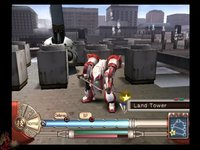|
|

|
PLATFORM
|
PS2
|
BATTLE SYSTEM
|

|
INTERACTION
|

|
ORIGINALITY
|

|
STORY
|

|
MUSIC & SOUND
|

|
VISUALS
|

|
CHALLENGE
|
Very Easy
|
COMPLETION TIME
|
20-40 Hours
|
|
OVERALL

|
+ Engaging and memorable cast
+ LIPS remains attention holding
+ Breezy, enjoyable fights
+ Plenty of replay incentive
- Not all that different from earlier titles
|
Click here for scoring definitions
|
|
|
For a long time it looked as if the Sakura Wars games would remain stuck in Japan. Back when the fever for releasing anime in North America was at its most fervent most of the animation specials released as supplements to the games made it across the Pacific, but without the Saturn and Dreamcast titles to properly introduce the characters they were inadequate. Then NISA took a chance on localizing what had formerly been Sakura Taisen V as Sakura Wars ~So Long, My Love~ — when no one had ever translated the six OVA episodes featuring the game's cast. I never expected to have the privilege of playing one of these games in English, and the experience is just as appealing now as it was for the rest of the series.
The fifth game in the series finds its former star Ichiro Ogami passing the mantel to his nephew Shinjiro Taiga, and promptly sending him to New York in order to become a part of its newly formed Combat Troupe. Shinjiro is initially treated like an unwanted eyesore by most of the people who perform at the Little Lip Theater, but eventually manages to prove himself a worthy leader of the Troupe. Doing this is vital because a scourge of evil beings has started to menace the city, and only a well-knit team with great appreciation for each other has a chance to save the Big Apple.
Taking the plot of a Sakura Wars game seriously is a recipe for a major headache, especially this one's fast and loose interpretation of New York in 1928. The overall story is also rather predictable, and anyone who cannot guess how events will conclude is very inexperienced. Sakura Wars fortunately takes place in an alternate history of steam-powered technology, and its freedom from the actual events of the past allows Red Company to craft a bizarre but very endearing tale. Knowing how things will turn out doesn't detract from the enjoyability of seeing the events unfold, and the characters are such an endearing bunch that their struggles are affecting. They also provide a great incentive to play the game more than once, since the core plot remains the same, but it is impossible to experience everything in a single playthrough. The climax also varies somewhat based on the girl Shinjiro is closest to, keeping the events from seeming quite the same in subsequent visits.
Shinjiro has to be nice to his teammates while wandering around New York, or else their battle performance will suffer. This entails using the LIPS system established in the earlier games. The core element of LIPS is that the player lacks leisure time to make choices on Shinjiro's behalf, and waiting too long to produce an answer in any given situation counts as a response in itself. This idea has several variants, and the PS2 controller allowed Red Company to insert a new one that requires the player to make motions using both analog sticks quickly. Usually pleasing the ladies isn't too difficult, and the system continues to be an effective and entertaining way of making sure the player is keeping close attention. Sometimes seeing the reactions of characters when Shinjiro chooses a bad response is even worth the relationship damage.
 Remember when a mass of demonic cannons protected a guy as he robbed Wall Street? New Yorkers must have been sleeping in that day.
Remember when a mass of demonic cannons protected a guy as he robbed Wall Street? New Yorkers must have been sleeping in that day.
|
|
The payoff for keeping the ladies happy comes in battle, where their performance is directly affected by how well Shinjiro has treated them in the preceding chapter. Just like the tactical combat in the third and fourth games, this one gives every character a gauge which slowly depletes upon taking any action. Stringing together multiple attacks in a chain will deal more damage than using single strikes that only drain one segment of the gauge, and characters can link their attacks to deplete enemy life all the faster. Battles will pose no threat to anyone with experience in the tactical realm, but they are an excellent example of how a combat engine can be entertaining without needing to offer a challenge. Fights are varied and demand different stratagems, while even a defeat is followed with the option of simply retrying, so that frustration is eliminated and enjoying the action comes first.
The robots in which the cast of Sakura Wars V fight can take to the air, which allows a new variant in the series' combat. Aerial encounters add the element of altitude to the proceedings, but otherwise are similar to the ground fights except with a different appearance. The added variety in combat is a good thing though, and helps differentiate this entry from its predecessors.
Nothing is wrong with the visual presentation of Sakura Wars V, but its similarity to the four preceding games is a bit baffling considering the processing power of the PS2. Kosuke Fujishima's character designs come to life via animation cells in front of backgrounds, using a process that is virtually indistinguishable from the first game back on the Saturn. Shinjiro's free movement uses 3D that takes some advantage of the system, and the combat portions look pretty good, but otherwise not much has changed. The art is still very well-drawn, but some additional animation during conversations, and more FMV clips overall, would have been easy to implement on the PlayStation 2.
 It is possible that some women will respond favorably to their sexiness being permanently dismissed. Gemini is not one of those women.
It is possible that some women will respond favorably to their sexiness being permanently dismissed. Gemini is not one of those women.
|
|
Kouhei Tanaka's musical contributions remain top-notch. The game begins with a new theme, "Warriors of the Earth," that is thematically similar to what the Tokyo and Paris groups had, and is remarkably catchy just like "Declaration! Imperial Combat Troupe!" and "Under the Imperial Flag" were. Much of the score is Dixieland-influenced, perfectly appropriate for a game set in 1928 New York with scenes in Harlem. The fact that most of the music is synthesizer only instead of the real instruments that kick in for vocal numbers is a little odd, but the compositions stand strong regardless.
The vocals of any Sakura Wars heroines are performed by actresses who will subsequently play the characters on stage, and so it was for this game. NISA was kind enough to offer the choice of hearing the dialogue in considerably more setting-appropriate English, and the performers do a good job in either language. NISA's localization may not be strictly faithful to the original at all times, but it keeps the spirit intact while making the words flow well, making for a very entertaining script.
It's a crying shame the sales for NISA's localization of this game weren't earth-shattering, because the fifth Sakura Wars keeps the charming appeal of its predecessors intact. The North American release is now two years old, and the original game came out in 2005, while no Sakura Wars VI has yet come to be. Even if such a thing never exists, ~So Long, My Love~ represents a great sample of what the series is all about. Playing it just has a knack for inspiring happiness from its sincerity, which is a thing to treasure.
Review Archives
|









